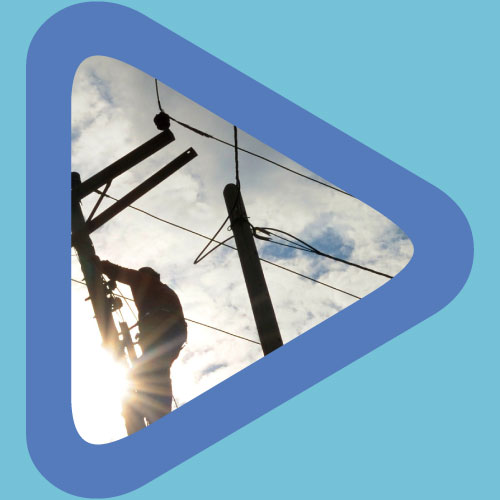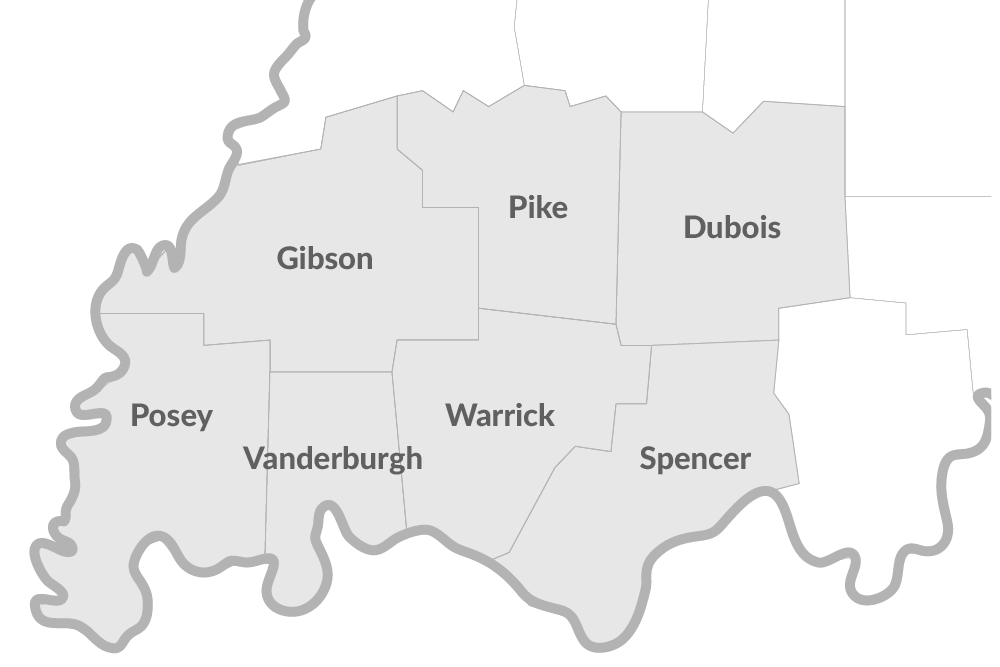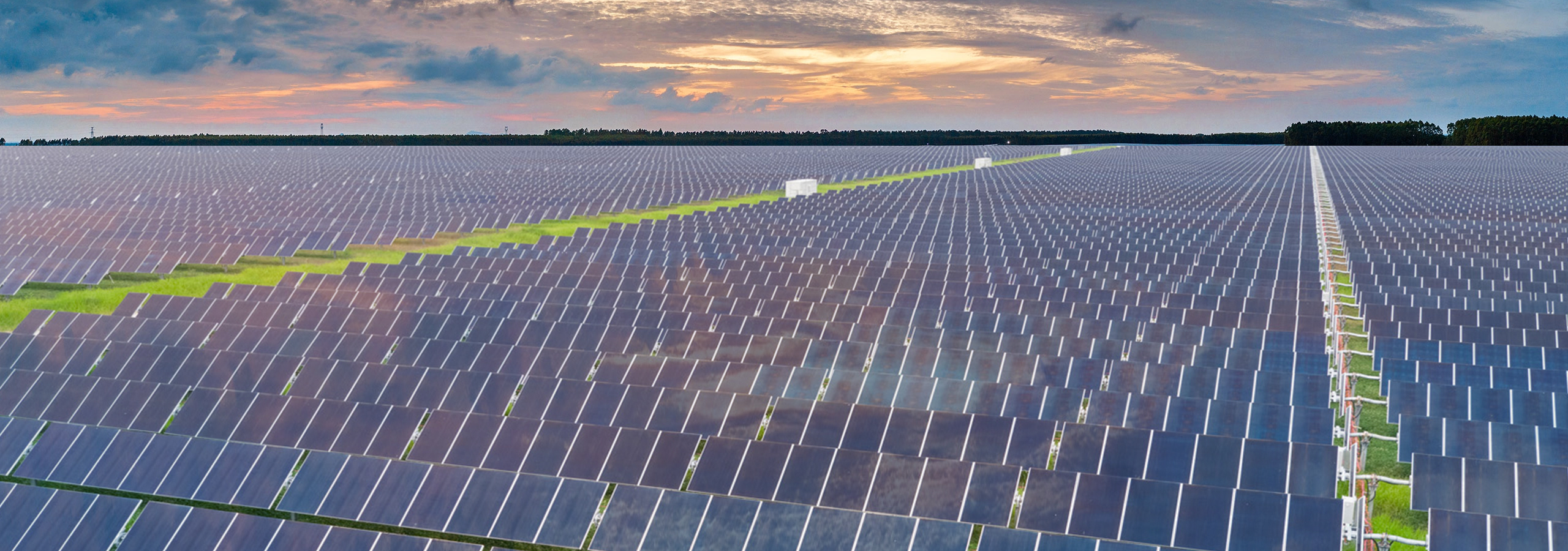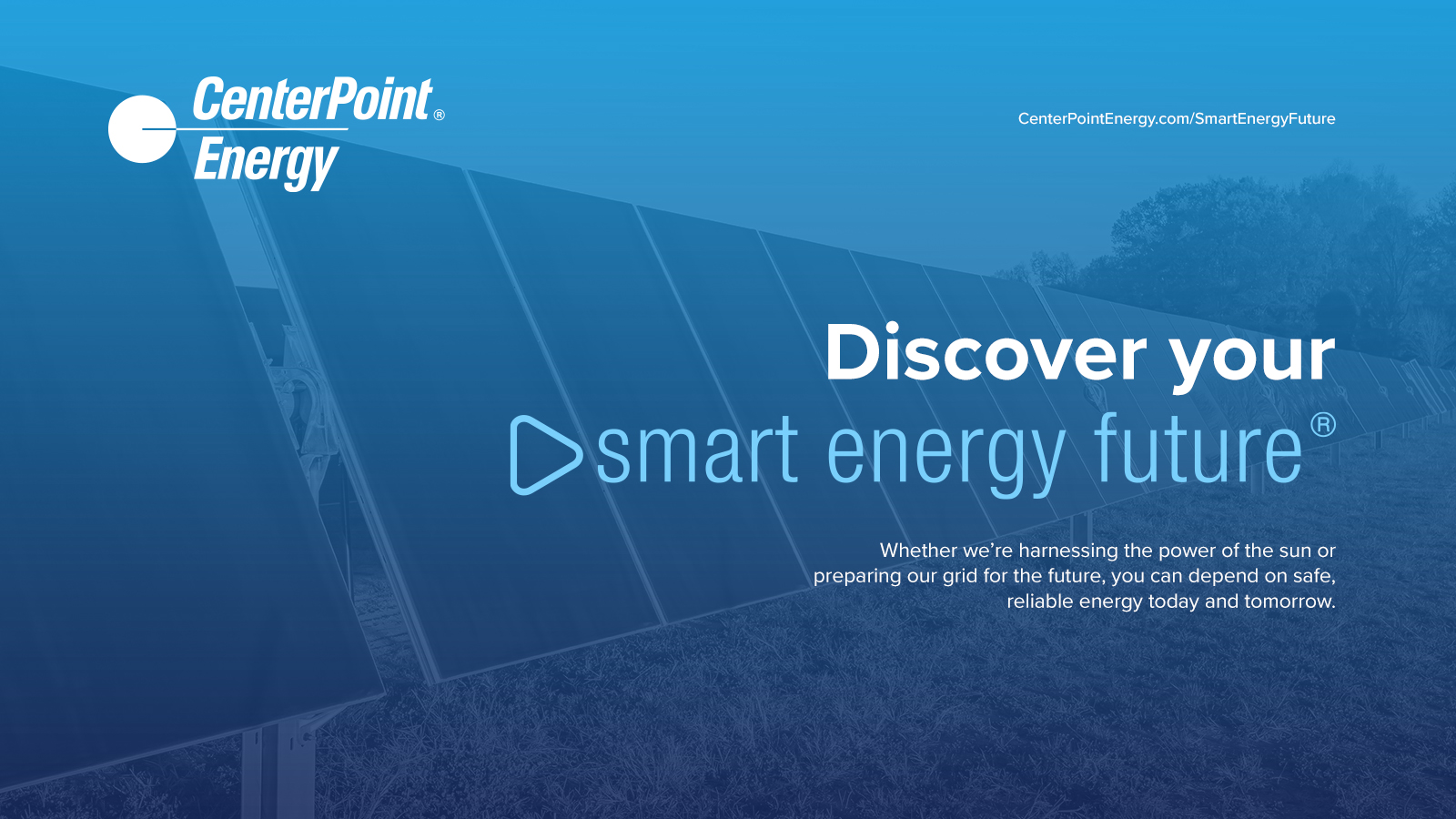You depend upon the electric service we provide, and we must provide it in a safe, reliable manner. As our older electric assets continue to age, and new and even more efficient technologies emerge, we have a plan for ensuring a reliable, reasonably priced and well-balanced energy mix for southwestern Indiana.
We are partnering in pursuit of a Smart Energy Future influenced by customers. We commit to ensuring continued reliability through a balanced and flexible energy mix and helping to create a cleaner environment driven by increased renewables and significant carbon reductions, all while responsibly managing costs.
Learn how you'll benefit from a smart energy future below, or visit our "Facts" page for answers to common questions.
Latest Updates
Residential customers using approximately 900 kWh per month are expected to see a nearly $5 bill credit per month on their bills.
Over the next five years, CenterPoint Energy plans to continue making strategic long-term infrastructure investments to maintain and enhance reliability and resiliency, manage life-cycle assets from aging equipment, and modernize the grid for customer benefit, while striving to safely deliver service.
Indiana-based electric business today announced its Integrated Resource Plan (IRP) preferred portfolio to further invest in renewable generation and end its use of Indiana coal by 2027.
CenterPoint Energy selects Pike County for 130-megawatt solar array development. Renewables represent third round of proposed solar agreements related to company's Smart Energy Future Plan.
Natural gas combustion turbines to provide reliable generation to complement transition to majority renewables portfolio, while reducing carbon emissions.
CenterPoint Energy has filed a request with the Indiana Utility Regulatory Commission (IURC) for securitization of assets of its A.B. Brown coal plant, which should result in a decrease to customers' electric bills by an estimated nearly $60 million versus traditional rate making.
CenterPoint Energy received approval from the Indiana Regulatory Commission (IURC) to energy into two power purchase agreements (PPAs) for an additional 335 megawatts (MWs) of solar energy.
This decision was based in large part on supply chain issues across the energy industry, as well as escalating commodity costs that have impacted the project schedule and timeline. Supply chain delays have affected manufacturers worldwide.
CenterPoint Energy received approval from the Indiana Utility Regulatory Commission to acquire a 300-megawatt (MW) solar array, as well as enter into a power purchase agreement (PPA) for an additional 100 MWs of solar energy as part of our long-term electric generation transition plan.
The total 335 MWs from these developments is expected to supply enough power to meet the needs of more than 70,000 homes or 12,000 commercial customers per year.
It's the next component in CenterPoint Energy's long-term generation transition plan which seeks to significantly change the way the company generates power and delivers on its commitment to provide a cost-effective, well-balanced energy mix for its 145,000 customers in southwest Indiana.
The facility is expected to generate enough power to meet the needs of more than 50,000 households per year and help large customers achieve their individual sustainability goals.
Securitization facts:
- We have listened to our customers/stakeholders and are working on cost-effective strategies to help keep customer bills as low as possible.
- The generation transition from coal to more renewable energy, backed up by traditional dispatchable resources, is expected to save customers in the long run over the continued use of coal plants. In fact, the next step in our generation transition plan to add more sustainable, renewable energy and convert the last remaining coal plant that we operate to natural gas is expected to save customers nearly $80 million dollars over the next 20 years.
- The securitization pilot, which was approved by the Indiana Utility Regulatory Commission in January 2023, is expected to drive nearly $53 million in additional customer savings in the long run versus traditional ratemaking for existing coal units.
- After June 29, 2023, when securitization bonds were issued, customers started realizing securitization credits on their bills.
- Q. How will I see savings?
-
A. Three new tariffs were implemented on June 29, 2023. The Securitization Rate Reduction ("SRR") removes net plant associated with A.B. Brown coal units 1&2 from customer rates. The Securitization ADIT Credit ("SAC") provides a credit for Accumulated Deferred Income Taxes associated with A.B. Brown units 1&2. The Securitization Coal Plant Charge ("SCP") is the charge to pay for the securitization assets.
- Q. What will my bill savings be and when will I start to see it?
-
A. Customers will start seeing lower bills beginning in July 2023. The table below shows the expected monthly savings based on monthly average usage per customer. For example, a typical residential customer uses approximately 900 kWh per month. At this level, a residential customer will see a bill credit of just under $5.00 a month. In all, securitization is expected to save customers nearly $53 Million versus traditional ratemaking.
Tariff Class SSR Credit SCP
ChargeSAC Credit Net
Securitization
Charge/
(Credit)Monthly
Average
Use Per
Customer
(kWh)Monthly Net
Bill ImpactRS ($0.013387 $0.009040 ($0.001060) ($0.005407) 899 ($4.86) B ($0.008371) $0.006030 ($0.000663 ($0.003004) 170 ($0.51) SGS ($0.013390) $0.009540 ($0.001061 ($0.004911) 504 ($2.48) DGS ($0.013230) $0.009390 ($0.001048) ($0.004888) 10,126 ($49.49) OSS ($0.012756) $0.009230 ($0.001010) ($0.004537) 9,174 ($41.62) LP/Other Large/BAMP/HLF ($0.006000) $0.004370 ($0.000475 ($0.002105) 1,541,293 ($3,244.12) Lighting ($0.006384) $0.007220 ($0.000836) $0.000000 $0.00 - Q. How does securitization work?
-
A. The remaining book value for AB Brown coal units (along with other qualified costs identified in Ind. Code ch.8-1-40.5) are financed through the issuance of long-term, low-cost securitization bonds. At the same time, AB Brown coal units, which were previously financed at a higher rate, were removed from customer rates. The net of the securitization charge and the removal of AB Brown coal units from rates will result in lower customer bills.
- Q. When was the securitization law passed?
-
A. On February 15, 2021, the state of Indiana passed SB 386. It became Ind. Code ch.?8-1-40.5, and allowing for a securitization pilot that benefits CenterPoint energy customers.
- Q. When will AB Brown coal units be retired?
-
A. The expected date of retirement is October 15, 2023.
- Q. Will CenterPoint earn money on retiring AB Brown coal units through securitization?
-
A. No. CenterPoint will recover the remaining principal balance of its investment upon the sale of securitization bonds and will no longer earn money on this investment.
- Q. Will CenterPoint earn money on securitization bonds?
-
A. No. The securitization bonds will be owned by investors. CenterPoint will be the collection agent for the securitization bonds until fully repaid. Customers will pay for the bonds through a non-bypassable charge.
- Q. Do all customers pay for the securitization charge?
-
A. Yes. It is required under the Indiana code.
For more information on this filing, please see the Legal Notice, or you can search docket number 45722.
The comprehensive plan is driven by our desire to:

Improve reliability
Maintain and enhance system reliability, and address aging infrastructure and install smarter technology.

Diversify our energy mix
Add new ways to generate power, like solar energy, to ensure a reliable and forward-looking future.

Enhance your experience
Integrate advanced metering systems to help manage energy usage and enhance communications regarding your service.

Our 7-county electric service area will see considerable upgrades and enhancements throughout the next seven years.
Our electric service area will see considerable upgrades throughout the next several years. These improvements include:
Changes in how we generate electricity to provide power to our customers
Improvements to how we deliver energy to your home or business so it's reliable and safe to use
Exciting new customer tools and options to help manage energy usage and bills.
Select a section below to learn more about a specific topic.
- Generation (how we produce energy)
-
A well-balanced mix for cleaner air and continued reliability
A well-balanced mix for cleaner air and continued reliability
During our final Integrated Resource Plan (IRP) public stakeholder meeting, we presented a preferred portfolio to diversify its electric generation fleet in the coming years.
The plan could save customers more than $320 million over the 20-year planning period and lower carbon emissions by nearly 75% from 2005 levels by replacing some older coal generation units with significant renewables, including a large percentage of universal solar.
This plan, which considered public stakeholder input, the outcomes of an All-Source RFP, and a wide variety of economic variables is the second consecutive IRP to point the utility in the direction of future resource diversity. Modeling conducted within the analysis points us to:
- Retiring or exiting agreements involving 730 megawatts (MW) of traditional generation, thereby avoiding investments estimated at $700 million to comply with strict environmental regulations
- Adding 700-1,000 MW of solar (some connected to battery energy storage) and 300 MW of wind renewable resources, which would allow all our electric customers access to solar-powered energy at significantly lower costs than customer-owned generation; and reduce carbon emissions by nearly 75%
- Adding 460 MW of natural gas combustion turbines; approximately half the natural gas capacity of the combined cycle gas turbine proposed in the previous IRP and designed to back up the renewable resources supplying the majority of our customers' energy needs
Building one of the largest solar farms in the Midwest
One of the largest single-site solar arrays was constructed in Troy, Indiana to further diversify our energy mix. This $70 million addition, constructed in our electric service area in southwestern Indiana, added 50 MW of solar power and consists of more than 150,000 solar panels over nearly 300 acres.
The Troy solar array is in addition to the 2 previously built 2-MW universal solar projects: the first near North High School in northern Vanderburgh County and the second near Oakhill Cemetery off Morgan Ave., which is through a partnership with the City of Evansville.

Retrofitting some and retiring other existing coal units
In addition to the solar projects, in April 2019, we received approval to retrofit our largest, most-efficient coal-fired generation unit, F.B. Culley Unit 3 at 270 MW in Warrick County, Indiana, to ensure it remains in compliance with EPA rules related to coal ash and waste water handling.
- System & grid (how we deliver energy)
-
A hardened electric grid that's safe and reliable
A hardened electric grid that's safe and reliable
The grid modernization plan will have significant benefits for the economy according to a study conducted by Indiana University, including an economic impact of nearly $650 million over the 7-year period, the generation of $20 million in state and local government tax revenue effects through 2023 and the creation of approximately 1,000 jobs at the peak of the plan. Here are a few of the improvements we are making across our electric service area:
Rebuilding high-voltage transmission line systems
Half of the transmission lines across our territory have been in service for more than 35 years, and those lines are subject to natural decay, animal damage and normal "wear and tear." Our $55M plan over the 7-year period includes efforts to rebuild transmission lines to meet our current standard of construction, which will result in improved power quality and reliability, reduced risk of emergency repair or replacement and better reliability.
Replacing substation transformers
Many of the 200 substation transformers in our system are well beyond their expected service life of 35 years. The loss of a substation transformer can result in the interruption of power to several thousand customers and restoration times can last for several hours. Proactive replacement of these aging transformers will help eliminate unplanned outages. This program, which costs nearly $69M over the 7-year period, will replace an average of 7 to 10 substation transformers per year.
Underground cable and network replacements
We will replace underground bare cable with coated primary conductor and upgrade a number of underground networks to maintain reliability and safety. This effort will cost about $55M over the 7-year period.
Rebuilding electric circuits
This $77M, 7-year program includes the replacement of obsolete and aged conductors with higher capacity and stronger aluminum cables, aging poles with poles based on current, more robust construction standards and other hardware as needed. Looping ties the circuits together with modern switches and improved grid resilience by providing alternate feeds for reenergizing customers during extended outages. This will ensure increased reliability and system integrity, reduced risk of poles breaking and falling in storms, reduced risk of wires breaking and falling during storms and faster restoration times.
Installing distribution automation
Distribution Automation will enable remote operation of switches so they can be opened and closed remotely from our control room. Adding this technology will cost about $14M over the 7-year period and will lead to faster outage restoration by quickly isolating outages to specific problems areas, improved preventative maintenance scheduling, enhanced safety and better data for system planning.
- Customer tools & options (new tools available to you)
-
New ways to manage your bill & service
New ways to manage your bill & service
Smarter meters
We rolled out new electric meters which virtually eliminate estimated bills, enable quicker service, faster electric outage identification, and provide more tools for you to manage your energy use. Smart meters are the key to supporting your smart energy future.
Energy usage monitoring
We’ve added new online tools that allow you to monitor your electric service down to the latest hour so you can schedule your thermostat more accurately and see the impact of new appliances or electronics. These tools are available to any electric customer with a free online account.
New texting options and alerts
You have new ways to communicate with us and stay informed about your service with Power Alert Service. This service includes texting/SMS power outage alerts containing the estimated time of restoration, high bill/energy usage alerts, and more.
Faster service activation
You'll have the capability to activate your service remotely, so activating or deactivating your service is quick and easy.

Bringing you smart metering technology.
Part of our grid modernization plan includes modern technology, which improves system reliability and resiliency, virtually eliminates estimated bills, enables quicker service, faster electric outage identification, and more tools for you to manage your energy use. Smart meters are the key to supporting your smart energy future.

Bringing you universal solar.
One of the largest single-site solar arrays was constructed in Troy, Indiana to further diversify our energy mix. This $70 million addition, constructed in our electric service area in southwestern Indiana, added 50 MW of solar power and consists of more than 150,000 solar panels over nearly 300 acres.
The Troy solar array is in addition to the 2 previously built 2-MW universal solar projects: the first near North High School in northern Vanderburgh County and the second near Oakhill Cemetery off Morgan Ave., which is through a partnership with the City of Evansville.
